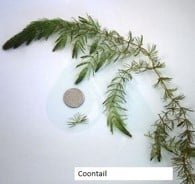Treatment for invasive and nuisance aquatic plants has been conducted on Lake Owasso since 1955. Such treatment requires a DNR permit and is performed by a qualified professional treatment contractor under the control of the DNR. For comprehensive and efficient treatment, the Lake Owasso Association (LOA) pools participating residents into one DNR permit. The LOA collects a signed form (normally emailed the end of February) along with payment for treatment. The signed forms are combined for submittal to a treatment contractor who in turn submits to the DNR for permit approval. The primary target plants include, Eurasian Water Milfoil, Curlyleaf Pondweed, (both invasive species) along with Coontail, Elodea, and Algae.
Treatment normally occurs around the first week of June. Prior to treatment, (late April and May) the treatment contractor performs various inspections to gauge the growth pattern of plants as they approach the surface. This information is documented into a GPS system and used to determine the best treatment method based on actual plant density, locations, and growth patterns. Post treatment inspections are also performed by the contractor to evaluate effectiveness. Information from subsequent inspections is used for potential touch up treatments. Inspections generally occur on calm sunny days to enable the best visual interpretations. Treatments are generally performed when winds are low.
Many variables affect aquatic plant density and growth rates. In general, low water levels enables deeper sunlight penetration which in turn promotes additional plant growth. Winters with minimal snow cover can also result in accelerated plant growth in the spring. Nutrient run-off has a major impact on plant growth in the lake. Controlling aquatic plant growth is a balancing act – too many invasive plants chock out native species which are good fish habitat. Too little plant growth can be associated with algae blooms and make for an unhealthy lake. Urban lakes have the added challenge of runoff from winter road salt.
Read more about Aquatic Plant Identification in Lake Owasso >>

